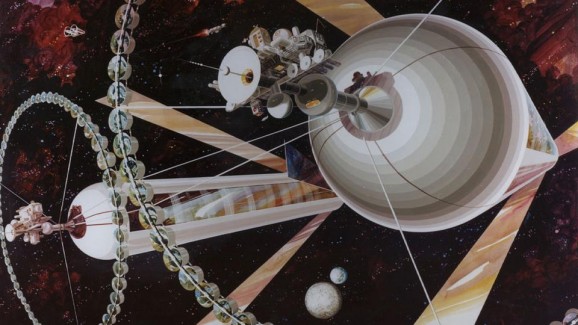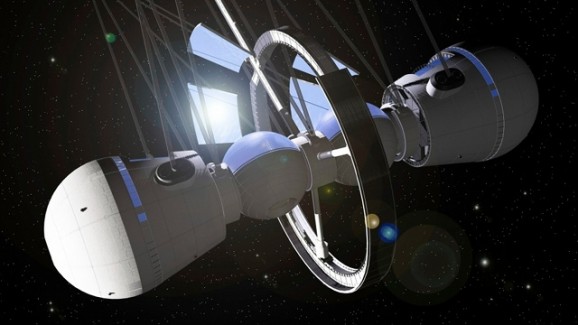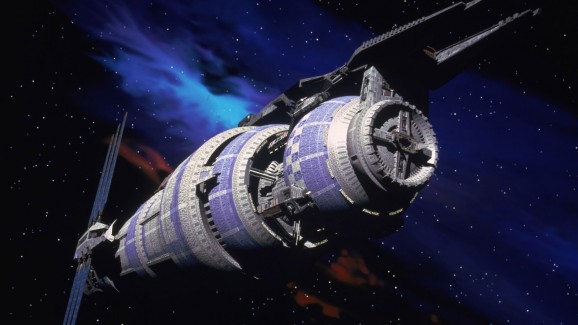British Interplanetary Society Wants To Build Rotating Space Colonies
I want to go to there.
 Mars One is currently the only thoroughly developed Mars colonization proposal currently on the table. The selection process for the first Mars colonists is currently underway, and if all goes according to plan — and that’s a big if — the Dutch non-profit would land the first humans on the Red Planet in 2023. Elon Musk, who echoes Stephen Hawking’s argument that humans need to colonize Mars to avoid eventual extinction, has grand plans to transport about 80,000 people to Mars via SpaceX’s Falcon 9 and Dragon capsules at about $500,000 a ticket. But some people, such as Mars Society Founder and President Robert Zubrin, author of The Case for Mars, thinks that we’re better prepared to send humans to Mars now than we were to send humans to the Moon in the ’60s. He has argued this for a long time, and is impatient at the lack of progress in landing colonists on Mars. And while Mars seems like a clear choice for colonization, other ideas have been circulating, such as colonizing the clouds of Venus. A recent proposal from the British Interplanetary Society is actually the resurrection of a 40-year-old idea to create rotating space colonies in space.
Mars One is currently the only thoroughly developed Mars colonization proposal currently on the table. The selection process for the first Mars colonists is currently underway, and if all goes according to plan — and that’s a big if — the Dutch non-profit would land the first humans on the Red Planet in 2023. Elon Musk, who echoes Stephen Hawking’s argument that humans need to colonize Mars to avoid eventual extinction, has grand plans to transport about 80,000 people to Mars via SpaceX’s Falcon 9 and Dragon capsules at about $500,000 a ticket. But some people, such as Mars Society Founder and President Robert Zubrin, author of The Case for Mars, thinks that we’re better prepared to send humans to Mars now than we were to send humans to the Moon in the ’60s. He has argued this for a long time, and is impatient at the lack of progress in landing colonists on Mars. And while Mars seems like a clear choice for colonization, other ideas have been circulating, such as colonizing the clouds of Venus. A recent proposal from the British Interplanetary Society is actually the resurrection of a 40-year-old idea to create rotating space colonies in space.
The British Interplanetary Society has a history of big ideas, some of which have proven feasible, such as their 1939 plan to send a manned lander to the Moon. They believed even then that existing rocket technology could get humans to our favorite big rock, which is pretty much what happened 30 years later. Now, the British Interplanetary Society’s Study Project Advancing Colony Engineering (SPACE), is attempting to prove that its new idea, which they originally conceived back in 1970, is also technologically feasible.

The idea behind living in a self-contained rotating colony completed with a carefully constructed biosphere is created to Gerard O’Neill, a Princeton physicist who came up with what’s now known as the O’Neill cylinder about 40 years ago. Science fiction has embraced the idea — Elysium and Babylon 5 offer glimpses of how an O’Neill cylinder might look in action. O’Neill, like Hawking and Musk, concluded that an advanced technological civilization may not be able to expand on Earth itself, which got him thinking about the types of habitats that might support such a future.

While SPACE’s plans are preliminary, its scientists do have a few details — such a cylinder would be solar-powered, given its ability to harness the sun’s energy at all times. The colonies would be located at La Grange points, the areas between two large bodies (the Earth, Sun, and/or Moon) where the gravitational forces are balanced, which eliminates the need for a propulsion system. The rotating of the cylinder would generate artificial gravity. There would be landscaped areas with plants, which would help recycle the oxygen, as well as a cloud-based water cycle.
As SPACE updates O’Neill’s plans (replacing aluminum with carbon composites, for example), it recognizes the challenge of funding such a project. The less expensive rocket launchers being built by companies such as SpaceX and Orbital Science will help, and the team believes that it can mine 90% of the construction material from the Moon. The plan may sound a little bit out there, but what space project doesn’t, at least initially? And if we have to leave Earth, a rotating cylinder in space might be a lot more comfortable than the freezing, unbreathable, and radiation-laden Mars. If John Sheridan is there to greet me, I’m in.












